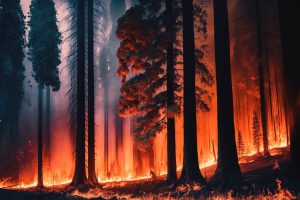WildFire In The United State,This article explores the causes, consequences, and ongoing efforts to mitigate the devastating impact of wildfires in the United States.
WildFire In The United States
In many ecosystems throughout the world, wildfires have long been a common occurrence in nature. However, the number, intensity, and size of these deadly infernos have increased alarmingly during the past several years in the United States.
The wildfire disaster has developed into a critical issue that necessitates prompt attention and comprehensive action due to the millions of acres of land burnt, the destruction of wildlife habitats, and the risk to human lives and property.
This article examines the reasons for wildfires in the US, their effects, and current initiatives to lessen their devastation.
The devastation of wildfires in the United States has increased, underscoring the urgent need for all-encompassing action. A multifaceted strategy is needed to combat this catastrophe, including tackling climate change, developing efficient forest management techniques, boosting firefighting equipment, and raising public awareness.
The United States can safeguard its natural landscapes, wildlife, and communities from the devastating effects of wildfires by giving priority to prevention, preparedness, and mitigation efforts.
Wild Fire In Canada
Canada, known for its vast wilderness and diverse ecosystems, is no stranger to the destructive force of wildfires. These natural disasters have had a significant impact on the country, consuming large areas of land, displacing communities, and threatening both human and animal life.
Wildfires in Canada present significant challenges to the environment, public safety, and the economy. The country’s diverse ecosystems and climatic conditions require a comprehensive approach to wildfire management. By investing in prevention, preparedness, and effective firefighting strategies, Canada can mitigate the destructive impact of wildfires.
Collaborative efforts between government agencies, Indigenous communities, scientists, and the public are crucial in ensuring the long-term resilience of Canadian landscapes and communities in the face of this natural hazard.
Wild Fire In Australia
Australia has a troubled and lengthy history with wildfires, sometimes known as bush fires. However, the nation has recently endured severe wildfire seasons that have garnered attention on a global scale.
These severe flames have destroyed large areas of land, destroyed wildlife habitats, endangered lives, and damaged the ecosystem and collective psyche of the country. The causes, effects, and ongoing initiatives to confront and manage the Australian wildfire disaster are all examined in this article.
The Australian wildfire problem has exposed the country to the enormous challenges that these natural disasters provide. Through continual initiatives to improve readiness and land management techniques.
The Causes Of Wild Fire
Climate Change: As a result of rising temperatures, protracted droughts, and altered weather patterns, wildfires are more likely to spread quickly across large areas.
Forest mismanagement: The accumulation of fuels in the forest, such as dead trees, dry underbrush, and alien species, makes wildfires more severe. Combustible materials accumulate due to poor land management techniques, such as fire suppression laws and infrequent controlled burns.
Human Activities: A sizable portion of wildfires in the United States are caused by human-related ignitions, such as campfires that are left unattended, cigarettes that aren’t put out, downed power lines, and intentional arson.
Fuel Load: Dry vegetation that has accumulated over time, including dead trees, shrubs, and grasses, serves as fuel for wildfires. The lack of conventional land management techniques and factors like invasive species and poor land management have all contributed to increasing wild fires.
Mitigation and Response Efforts
Fighting fires: Skilled firefighters battle wildfires with the assistance of federal and state organizations. To contain and put out the fires, they use a variety of tactics, including building firebreaks, carrying out controlled burns, and using airborne resources.
Preparedness and prevention: Public awareness initiatives, neighborhood planning, and laws governing fire prevention all contribute to lowering the danger of wildfires. Prompt evacuation and response are also made possible by enhanced forecasts, early warning systems, and disaster preparedness procedures.
Forest management: Using proactive techniques like controlled burns, thinning out thick vegetation, and forest restoration can help lessen the severity and intensity of wildfires.
Mitigation of Climate Change: Reducing greenhouse gas emissions, switching to renewable energy sources, and promoting sustainable land management are all necessary in order to address the fundamental cause of wildfires.
Research and Technology: Improvements in wildfire prediction and detection, satellite monitoring systems, and early warning tools help with quicker response times and better resource allocation.
Improved Land Management: Methods for reducing the effects of wildfires, including strategic fuel reduction, controlled burns, and the adoption of indigenous land management practices, have received prominence.

What are The Consequences of Wild Fire
Environmental Impact: Wildfires affect ecosystems by displacing wildlife, destroying plants, and upsetting the equilibrium of the ecosystem. By decreasing the ability to sequester carbon, the disappearance of forest cover exacerbates climate change.
Public health issues: Wildfire smoke causes serious health risks, particularly for vulnerable populations. Fine particulate matter inhalation can cause respiratory issues as well as other harmful health impacts.
Economic Losses: Wildfires cause significant economic losses due to the destruction of buildings, infrastructure, and farmland. Budgets at the federal, state, and local levels are also heavily burdened by the expenses related to fire suppression operations, insurance claims, and post-fire recovery.
Conclusion
The wildfire epidemic affecting Australia, Canada, and the United States has exposed the country to the enormous issues these natural disasters bring. through continual initiatives to strengthen readiness and advance land management techniques.

